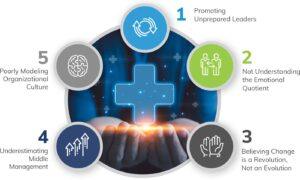How to develop leaders and cultures that prioritize innovation
Executive Summary
Some leaders are born, others are developed:
- Successful leaders display specific qualities and competencies
- Great leadership helps organizations thrive
Executive leadership must drive the progressive process of cultivating organizational culture, a critical component for organizational success.
Leadership lessons:
 Tap leaders who are ready and prepared for their next role
Tap leaders who are ready and prepared for their next role- Make Talent Development a priority – build a great bench and encourage leadership growth
- Having emotional intelligence is THE critical competency today!
- Recognize that all leaders are flawed and make mistakes – those who demonstrate humility and learning are the ones who succeed
- Support your people, listen with intent, and be curious
- Inspire others through a shared mission and purpose
- Develop your leadership style and know your ‘why’
WHAT MAKES A LEADER?
Being a leader is undeniably hard, and today’s healthcare environment creates new and demanding challenges that leaders must forge through. Leaders are human beings first, and they bring both qualities and competencies to their role: some good, some not so good. Leadership qualities are characteristics that reflect who you are and influence your personality, while competencies are the skills and knowledge gained through the act of doing or learning. Knowing and understanding your personal qualities and key competencies is critically important to leadership development and building healthy teams and organizations.
Key qualities that great leaders often possess include:
- Integrity, which is built through trust
- Empathy, which is gained from listening and understanding
- Agility in decision-making and adapting to change
- Courage to seek help, make tough decisions, and take risks—in fact, leadership courage is often what helps leaders flourish through the toughest challenges
Leadership success also requires essential competencies:
- Communication allows you to tailor messages across various stakeholder groups
- Intellectual Intelligence provides the ability to think clearly, solve problems, continually learn, and know when to seek experts for situations where your experience is lacking
- Emotional Intelligence gives you the opportunity to fully see, comprehend, and thoughtfully respond to all that is happening around you
These attributes and abilities are powerful tools to help a leader create a winning culture and strong community that works together to achieve an organization’s goals. A leader sets the tone for culture by reinforcing the behaviors, norms, and values of the organization. Healthcare organizations are filled with people who by nature bring variation, differences, and purpose. It is impossible to create a perfect culture or a perfect organization. Effective leadership is the guiding force to inspire cultural transformation and embrace humaneness. When you have effective leaders you are better able to accomplish the organizations mission and vision.
6 Priorities for Leadership Success
Authentic and compassionate leaders resonate throughout an organization, and even more so today as our workforce evolves. Successful leaders share a clear vision of where their team(s) and organization are headed, develop people’s skills, and then give them the tools and freedom to achieve their goals. Effective leadership involves several smaller investments and trust that produce larger returns.

1 | Seek to Understand and Listen More
In a tight labor market, healthcare leaders face a delicate balance—maintaining a focus on patient care while strategically steering an organization toward efficiency, innovation, and quality care. These leaders must effectively attract and retain dedicated healthcare employees who provide quality care and service excellence, while navigating challenging workloads and limited resources. Demonstrating emotional intelligence by recognizing and addressing these demands becomes paramount, signaling to the team that their challenges are acknowledged and understood. This approach not only fosters a supportive culture, but also opens avenues for collaborative problem-solving by empowering teams to innovate and collectively enhance care delivery. By actively listening, understanding, and expressing empathy, healthcare leaders can cultivate environments where the well-being of both the team and patients is prioritized, ultimately contributing to the team’s and organization’s resilience and success.
2 | Champion Innovation
By championing innovation and technology-forward approaches, healthcare leaders can guide their teams toward efficiency while also improving the delivery of care. Implementing advanced tools such as the latest scheduling software enables the strategic alignment of limited staff with case volume demand; therefore, optimizing resource utilization. Incorporating technologies such as heatmapping and predictive analytics provides invaluable insights that allow leaders to accurately forecast needs. Moreover, fostering a collaborative environment becomes seamless through the integration of communication systems, enhancing coordination between teams and leaders. This commitment to innovation not only streamlines operations but also positions healthcare organizations at the forefront of transformative healthcare practices.
3 | Embrace Generational Mentorship
Mentorship is a timeless approach to learning, pairing new healthcare graduates with seasoned professionals. The nuances of patient care, individual interactions, and collaboration are best learned through hands-on experiences. Experienced healthcare professionals bring both clinical expertise and invaluable insights into organizational efficiency and effective communication. This transfer of knowledge—rooted in emotional intelligence and empathy—ensures the preservation of high-quality care. Unfortunately, the growing workforce shortage is complicating on-site training, development, and precepting of the future workforce. As units wrestle with understaffing, time devoted to mentoring erodes. To sustain this crucial learning model, it is important to acknowledge the impact of mentoring and address potential barriers to ensure this learning continues. Key components include: finding new ways to foster the transfer of knowledge, continuing the practice of lighter workloads for mentors to counteract stress, fostering better-modeled behaviors, and selecting adept clinicians who are naturally competent at seamlessly transferring generational knowledge. By prioritizing and appropriately supporting mentorship programs, healthcare leaders will be protecting the continuity of exceptional care today and well into the future.
4 | Prioritize People
We have all experienced the phenomenon of seeing a good leader resign to go to another organization, and then watch their team follow them. Why does that happen? It is because they prioritize their people, through recognition, expressing gratitude, and development. Exceptional leaders who cultivate a reputation for being a good leader are empathetic, attentive, and possess people management skills that draw the best employees who are loyal. Their brand becomes a magnet for employees who want a culture committed to high-quality care and collaboration. Organizations (and leaders) that do this well typically offer robust development opportunities and recognize each individual as a unique person with distinct goals. As a leader, it is important to be the catalyst that employees willingly follow, envisioning a shared journey toward success for the employee and organzation. Implementing referral programs further solidifies this approach, leveraging the positive narratives and experiences of current employees to entice great talent. By acknowledging and compensating employees for their word-of-mouth efforts and network contributions, an organization solidifies its position as a winning team that others aspire to join.
5 | Live Your Mission
Embodying a mission is not just a statement—it is a dynamic force that builds stability and common purpose. Strong leaders chart the course for the organization and actively drive its progress, guiding teams through a clear plan that aligns with the vision and values. Clearly articulating the future makes it easier for all stakeholders to understand. A compelling mission—such as providing quality care, being the community’s best, and ensuring universal access—serves as a cornerstone of success. Inspiring a robust culture involves multiple facets, from nurturing and engaging the workforce, to understanding what exceptional talent looks like. Effective leaders identify individuals who resonate with the mission, values, and the commitment to compassionate care—ones who will continue to reflect the organization’s core values with passion. However, it is not enough to articulate these goals; effective leaders live out the mission in the hallways and demonstrate it daily, so others see it, feel it, and emulate it.
Understanding your ‘why’1 is foundational; without it, efforts often fall short.
6 | Continuously Apply Past Learnings
Great leaders learn from their past experiences and apply those lessons, whether the experience had a positive or disappointing outcome. It takes failure sometimes to really understand and reflect on one’s leadership competencies and what the organization needs. Albert Einstein once said, “Failure is success in progress.” Leaders who embrace and foster the “fail fast” mentality will see their organizations achieve better outcomes faster and create a culture of innovation and engagement.
Additionally, today’s dynamic environment of healthcare executive turnover provides an opportunity for a richer exchange of ideas and practices across different markets. It also prompts leaders to ask crucial questions confirming the problems that need to be solved, why those problems matter, and how to involve key stakeholders in the process. Fresh eyes in an organization can offer new ways of thinking that perhaps are missing within an organization. Executives who have served in several organizations and markets have a broader perspective that may be helpful in driving change, innovation, and success. Today, executives seem to move organizations (between zero to five years), which can contribute to the leader’s growth as well as transplanting successful strategies across diverse healthcare landscapes. This is just one of the silver linings of leadership turnover.
CASE STUDY: Solutions to staff shortages
Years ago, working in a large integrated healthcare system with over 15,000 employees, through the efforts of a cross-functional team to address staff shortages, we were able to address talent shortages while fostering career growth as a key priority. One innovative approach involved strategic partnerships with local academic institutions to address workforce gaps. Collaborating with Marquette University, we tailored a master’s program for nurse leaders, cultivating our own talent pool and building our own future. Additionally, in recognizing the shortage of surgical technicians, we partnered with MATC, creating an accelerated training program. We found individuals interested in promotional opportunities and trained those employees selected to enhance their skills. Utilizing many of our own resources and experts, along with partnering with the academic specialists, we were able to develop future surgical techs while promoting and recognizing employees interested in growing their careers. While these initiatives required an upfront financial investment, we were investing in our future and our people. These creative solutions led to greater trust and commitment from our people and strengthened our culture of employee development and recognition. With the challenges today in workforce shortages, this approach is essential to developing a pipeline of talent.
5 Leadership Pitfalls
The passion for leadership comes naturally for some people, while others learn through experience and practice. All leaders learn from their leaders, both good and bad behaviors. It is the combination of discerning our experiences and embracing leadership attributes that allow each leader to serve authentically but with common and developing leadership competencies. The most effective leaders are on a journey of improvement to become a better form of themselves. Growth leadership is essential to stay on top of their game and continually learn. Below are 5 pitfalls leaders typically struggle with. Understanding and overcoming these issues not only makes better leaders, but also facilitates stronger cultures and organizational effectiveness.

1 | Promoting Unprepared Leaders
In response to the shortage of rising leadership talent, executive leaders and organizations may be tempted to prematurely promote a high individual performer into a leadership role. We see this often in the clinical areas, with promotions of individuals with exceptional clinical skills but limited leadership competencies. Recognizing that clinical proficiency does not necessarily translate to effective leadership, healthcare has a crucial need for targeted leadership development.
To place clinicians in management roles, organizations must prioritize mentoring in operational and human resource management. Modeling best practices across business, patient care, interpersonal dynamics, and organizational structures is essential. Fostering mentorship, cultivating business acumen, and staying updated on evolving technology capabilities are crucial for shaping future leaders.
2 | Not Understanding the Emotional Quotient
The significance of emotional intelligence (also known as the Emotional Quotient or “EQ”) in leadership cannot be overstated; it may be one of the most critical competencies. Effective leaders possess the ability to read a room and quickly comprehend the mood of customers and staff. Understanding their desires and needs and meeting them where they are—both in the moment and in the long term—requires a nuanced and intricate skill set. Even seasoned leaders may struggle with this complexity, and for less experienced leaders, it can be more challenging.
Executive leaders cannot assume all leadership talent has strong (if any) EQ. They must model it, test it, and train for it. Guiding and shadowing others can help rising leaders build stronger EQ, which empowers them to discover their authentic voice and style. Ensuring rising leaders have access to highly competent EQ leaders to learn from is essential. Together, these valuable elements shape individual leadership experiences, backgrounds, and understanding of what to do and what not to do.
3 | Believing Change is a Revolution, Not an Evolution
Research2 proves that it takes years to make a full cultural shift. This is why the goals of change must be kept top of mind by executive leaders, every day, at every meeting, during every interaction, and in every moment where others can see and hear the people setting examples for change. This includes hiring the right people who fit with the values, mission, and culture that the organization is striving for. Cultural goals must align with recruitment and retention efforts to embrace people who share the organization’s passion, mission, and values. This will help facilitate commitment and the development of culture. Being patient while consistently moving the organization in the direction of the culture a leadership team seeks to develop must be a priority.
4 | Underestimating Middle Management
With shrinking resources, executive leaders need to mentor, develop, and let go! Utilizing and delegating the leaders closest to the teams and their work is essential to getting things done efficiently and effectively. Unfortunately, too often executive leaders keep too many priorities on their plates instead of trusting their teams to accomplish priorities. Executive leaders need to challenge themselves and each other to let go and trust to lead a high-performing organization.
Effective middle management leaders have the greatest ability to impact an organization’s culture because they are the ones directly leading front-line staff. Often nurse directors have 60 or even 100 direct reports. They are active in the units, walking the halls, and interacting throughout the facility with people from all stakeholder groups. They are listening and talking to employees and patients and have their finger on the pulse of the organization. This provides them with a crucial source of information and perspective to share with executive leadership. It also allows them to help shape the culture to recruit and retain staff. Smart executive leaders rely on this important role to accomplish the work, be key ambassadors of the mission and promote the organization’s values.
5 | Poorly Modeling Organizational Culture
While it takes years to shape culture, it may only take moments to erode it. That is our great challenge as humans. When we do not show up as our best selves, it has the potential to disrupt positive change. It is critical for executive leadership to set expectations for all leaders and all employees, to model the desired culture and demonstrate it daily to patients, families, and each other. In doing so, leaders must also acknowledge this process will take time, and sometimes people will fail at it.
Final Thoughts
Leadership is not an easy task, and our modern healthcare complexities amplify difficulties. The ever-increasing demands, coupled with the expectation to do more with less, necessitate a collaborative and trustworthy leadership approach. Unlike in the past, where leaders were expected to have all the answers, today’s effective leaders acknowledge their limitations and embrace authenticity. They operate as skilled conductors, leveraging agility and bringing in diverse resources to solve complex problems. Effective leaders do not need to possess all the expertise but must excel in decision-making and resource utilization.
With our growing population of aging patients, demand for care is accelerating. Leaders within our industry face an uphill struggle to meet this critical need. Healthcare is unique in its opportunity to impact lives and make a significant difference for others, often when patients are most vulnerable. This is the “why” so many choose to serve. Modern leaders must be resilient, agile, and dedicated to this important human experience in order to guide their organizations into the complex and forever changing future.
Sources
1 Sinek, S. (2009). Start with Why: How Great Leaders Inspire Everyone to Take Action. Penguin.
2 Walker, B., & Soule, S. A. (2017). Changing Company Culture Requires a Movement, Not a Mandate. Harvard Business Review.



